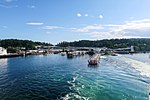Institute of Ocean Sciences
Biological research institutesBritish Columbia stubsBuildings and structures in British ColumbiaCanadian federal government buildingsFisheries and Oceans Canada ... and 6 more
Fisheries and aquaculture research institutesOceanographic organizationsResearch institutes in CanadaSaanich PeninsulaScience and technology in CanadaSouthern Vancouver Island

The Institute of Ocean Sciences is operated by Fisheries and Oceans Canada and is one of the largest marine research centres in Canada. It is located on Patricia Bay and the former British Columbia Highway 17A in Sidney, British Columbia on Vancouver Island just west of Victoria International Airport. The institute is paired with a Canadian Coast Guard base, and makes use of the ships CCGS John P. Tully and CCGS Sir Wilfrid Laurier as well as the Japanese RV Mirai.
Excerpt from the Wikipedia article Institute of Ocean Sciences (License: CC BY-SA 3.0, Authors, Images).Institute of Ocean Sciences
West Saanich Road,
Geographical coordinates (GPS) Address Nearby Places Show on map
Geographical coordinates (GPS)
| Latitude | Longitude |
|---|---|
| N 48.65 ° | E -123.448 ° |
Address
West Saanich Road
V8L 4B2
British Columbia, Canada
Open on Google Maps




